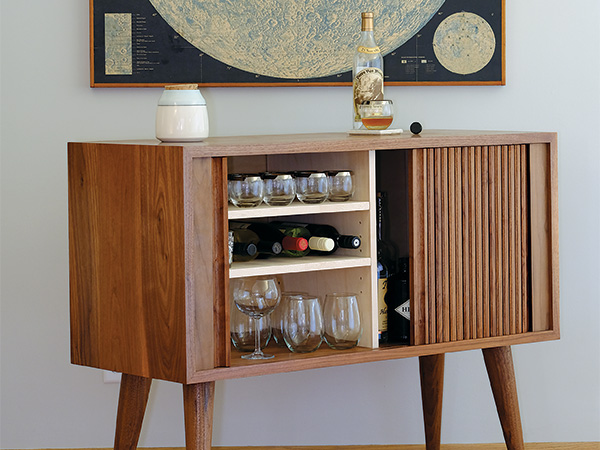
As I was growing up, the furniture in our home was Mid-Century Modern style. Of course, then it was just furniture … period. So that may be one reason that I am drawn to the style. Not everything Mid-Century Modern strikes my fancy, but this console certainly does.
When you first look at the piece, it is easy to miss many of the fine details. And that is one of the truly pleasurable things about this console — the more you look, the more you like. The wood grain of the solid walnut flows around the carcass. The tambour doors provide excellent access to the interior and are a stunning collection of vertical lines when closed. The angled and tapered legs (also of solid walnut) have the mass to balance the carcass and draw your eyes up from the floor. The interior of the console is made from naturally finished maple plywood, making the most of the light that bounces into the recesses of the cabinet. And, while certainly not last, the finish on the hand-selected walnut lumber brings out the rich color of this truly American wood. There are many more lovely details, but I will leave them for you to discover. Even so, I would like to give a nod to Jacob Garrison and others on the Journal’s staff for the work they did in designing this project.
Waterfall Corner Joinery
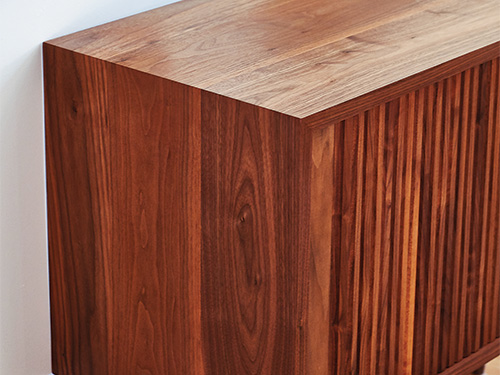
Waterfall joints are a subtle but lovely design feature that has gained popularity lately. Featured on kitchen islands in cable TV home improvement shows, this particular type of mitered corner has become nearly ubiquitous. That’s really what we are talking about: mitered corners, conceived in such a way as to allow the grain of your panel to “flow” around the corner.
So, what are the details to keep in mind when you are considering a waterfall joint? Let’s start with the most obvious: the panel from which you’ll cut your corners has to be long enough to have continuous grain — in our example here, the “waterfall” flows between the sides and the top. Our bottom panel does not have continuous grain.
Next, if you are using a solid wood panel, aligning the stock as you glue up the large panel can be a challenge. Splines or biscuits can make that task easier, but be careful not to locate them where future machining will expose them to view. Take time to “compose” the panel, arranging the boards for the most pleasing blend of grain.
Additionally, you will need a way to accurately cut the miters in your panel. This is critical. (Here we constructed a crosscut sled for the table saw to make that happen.) Finally, you’ll need a way to accurately align the miter joints while wrangling a really large project. Again, splines or biscuits are lifesavers here. Having a friend around during the glue-up is also a good idea.
You Can Build This!
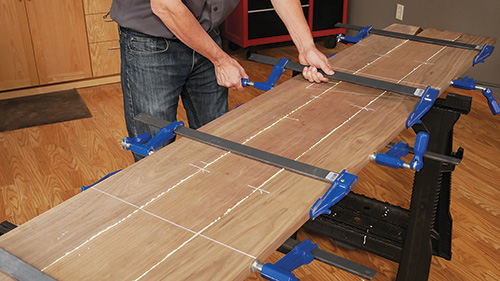
The techniques required to build this console are not overly difficult and are within the skill level of most woodworkers. The biggest challenge is surfacing the wide walnut panels. This task can be achieved using a variety of solutions, but it should be considered before you start.
Go ahead and get your solid lumber and bring it into your shop for a week or so to get it acclimated to its surroundings. Purchase about 30% more 5/4 roughsawn walnut than you think you will need to allow for regular waste and an “oops” here or there. To accommodate the waterfall miter joinery, you will need boards of sufficient length: just a bit under 8′ of length as long as there are no serious flaws in the stock. Surface the lumber to just a bit thicker than 1″, say a scant 1/16″ over, so you can flatten the glued-up panel later and retain the 1″ thickness. Joint the edges of the lumber to flatten and square them 90° to the faces of the stock.
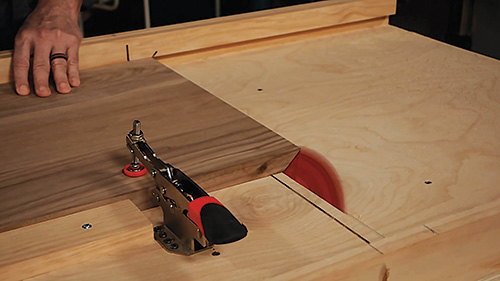
Now you need to compose the panel (put the boards together so the grain pattern is most pleasing) and do a bit of noodling regarding how you will glue and clamp the panel together. We used biscuits to help keep the boards’ edges nicely aligned during the gluing and clamping phase. I also chose Titebond® III for this task, as it has a longer open time. Every little thing can be helpful. One note about the biscuits used to align the long boards: plan ahead and keep their locations out of the area where the mitered corner joints will occur. At this time, I also glued up the stock to make the bottom panel of the console. Once the glue has cured and you’ve removed the glue squeeze-out, it is time to cut the miters. The crosscut sled we built for this task had a couple of special features. Purpose-built cleats and a toggle clamp held the panels securely. I first cut the panels to their exact size and then tilted the blade over to form the miters on the smaller pieces. Between those two cuts, I surfaced the panels to their 1″ thickness.
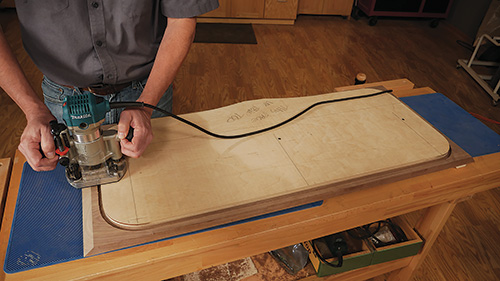
With the four large walnut carcass components cut to size and mitered, form a 1/4″ x 3/8″ rabbet on their interior back edges. When that’s done, it is time to rout their inside faces. But before you can do that machining, you need to construct a template to guide the router. In the Drawings, you’ll find the details to create the template. It allows you to plow the tracks that the tambour doors will slide in as they open and close. I used a 5/16″ straight bit chucked in my router and a properly sized rub collar to guide the tool. Because the interior will not be seen, I screwed the template in place to be certain it would not move as I routed.
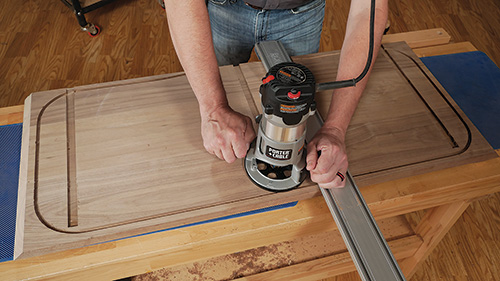
And here is an important point. Try as you might, when you create the template, it is unlikely to be exactly symmetrical. Because of that inaccuracy, if you were to trace the shape of the template onto a large piece of paper, then flip the template over and trace its shape again, you would see that the lines would not match perfectly. To avoid plowing mismatched tracks into the top and bottom panels, mark the opposite faces of the template “top” and “bottom.” When you plow the track in the top, you should see the word “top,” and you should see the word “bottom” when routing the bottom. Doing that will keep the tracks perfectly aligned despite template irregularity.
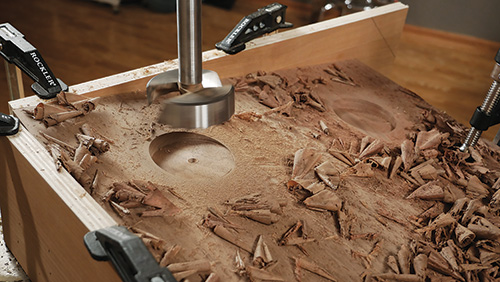
For the last bit of routing, plow the dadoes that will later accept the vertical dividers. These are stopped dadoes sized to match the plywood thickness. See the Drawings for details. With that done, you have just a couple more tasks before you can glue the carcass together. The first is to form the angled leg mortises in each corner of the bottom. I did that by building a jig to hold the bottom at the 7° angle on top of my drill press table. I made use of a 2-7/8″-diameter Forstner bit to excavate the round mortises. I tested the setup using some scrap plywood before I drilled into the walnut bottom (better safe than sorry). Later, the legs will be turned to fit tightly into the angled recesses.
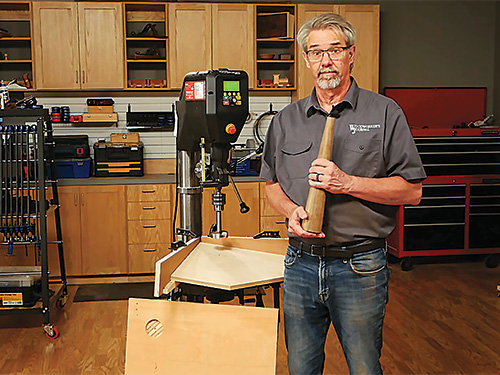
Before you leave the drill press, take the time to bore a hole through the bottom at the center of each leg mortise. You can use the same jig as you drill these 3/8″-diameter holes. Later, you will use these holes when you mount the legs with threaded inserts. Don’t be alarmed when the 3/8″ holes intersect with the dadoes; they’re supposed to do so. In fact, now would be a good time to chop out the four tiny mortises to fit the ends of the T-nuts that will be installed later.
Glued-on Clamping Cauls
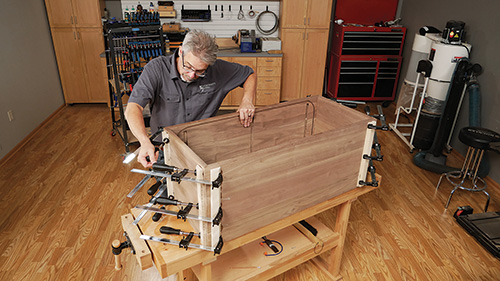
Gluing and clamping together a large mitered cabinet like this is no small challenge. I took two steps to make it easier. First, I sliced three biscuit mortises per corner, to once again aid in keeping the joints perfectly aligned. Second, I made clamping cauls from scrap plywood. I glued those cauls in place on the outside corners of the sides, bottom and top, using a single squiggly line of liquid hide glue. I just rubbed the cauls back and forth until they “grabbed,” employed a couple of Rockler Bandy Clamps to hold them securely and then let them cure for an hour or so.
I can almost hear you saying, “Why in the world would you glue those ugly chunks of plywood to the cabinet?” Don’t worry, they are just temporary: after the console is assembled, you will take a chisel and break the cauls away. A little sanding and scrubbing with some water (a big advantage of hide glue’s reversibility!) and you will never know the cauls were there — except that the miter joints will be as tight as can be.
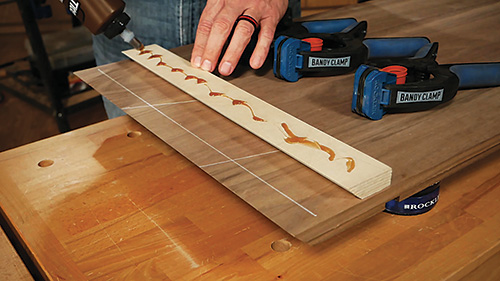
It is always a good idea to do a dry assembly to check out your joinery. That also gives you a test run to determine how complicated the glue-up process will be. The clamping cauls make this gluing and clamping process so much easier to do. If the glue joints fit well, go ahead and apply glue and clamp the carcass together, and measure the diagonals to verify it is square. Allow the glue to cure for several hours, overnight if possible. After the glue cures, use a wide chisel and a mallet to pop the cauls off of the walnut. Do this by laying the flat back of the chisel on the walnut, and use the bevel of the chisel as a wedge to pop and pry the cauls free. Then sand and wash the hide glue residue away.
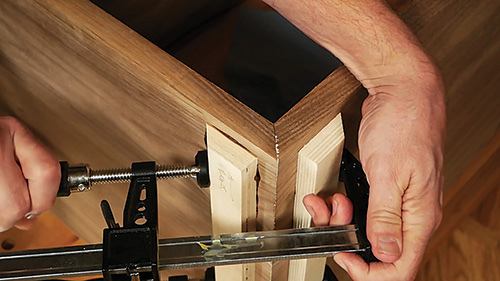
Now go ahead and build the legs. They are made from glued-up walnut blanks measuring 3″ x 3-1/4″ x 17″. Their shape is a straight taper that starts at 2-7/8″ at the wide end and reduces to a 1″ diameter at the narrow end. I mounted mine on the lathe by drilling a hole for a threaded insert at the wide end and then using a mandrel in the drive head of the lathe. (The threaded inserts and bolts are optional, but I found them to be a good idea.) A standard live center will work at the narrow end. Start with a spindle roughing gouge, get the shape close, then switch to a square-end scraper. If you are comfortable with it, finish the task with a skew chisel. Sand the legs smooth all the way up to 600-grit paper. With that, the shaping is done, but before you set them aside, take a few minutes and seal the end grain of the wide end of the legs with hide glue. Later, you’ll use the same glue to secure the legs in their mortises. This step will make the leg joints much stronger.
Tambour is Terrific!
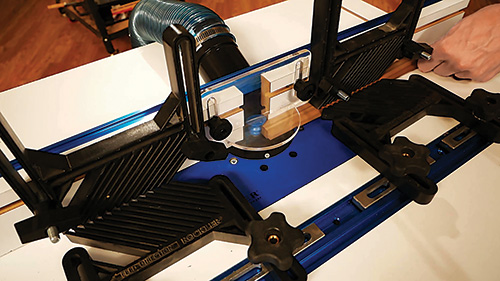
If you have never made a tambour panel before, it can seem a bit tricky and even overly complicated. But in truth, it is really pretty easy, especially when you use Rockler’s tambour cutting router bits. Following the directions on the tambour bit packaging, cut your stock to its width and thickness. I chose to leave the pieces long, rather than cut them to length before I machined them. I think it saved time. Each piece needs to be machined twice. Make sure you shape enough stock to have a few extra pieces, then cut the pieces to length.
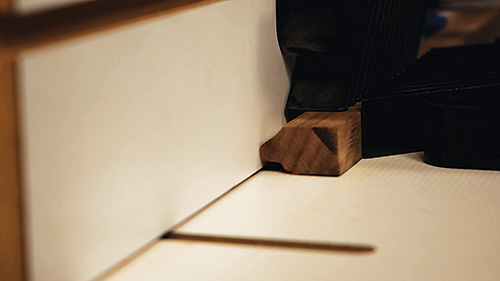
The next step is to cut a small rabbet into the front-facing ends of each piece of tambour. These rabbets will allow the pieces to fit and slide in the top and bottom tracks. I made a little jig to hold each piece and used a dado stack to form the rabbet on the table saw. See the Drawing at right for the tambour details.
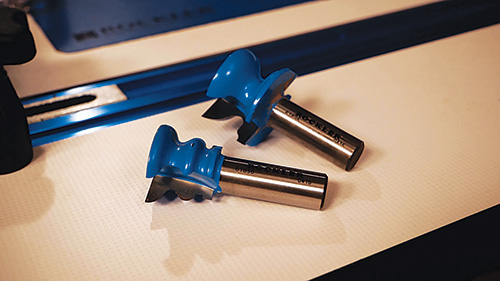
With the machining done, you’ll need to hold the tambour together as you assemble the separate sticks into a sliding door. You join them by gluing them to a canvas backing. I used liquid hide glue to glue the canvas to the tambour, but the tambour sticks need to be tightly held together as that process happens. So build a frame on a plywood substrate. Keep one of the three frame pieces removable so that you can screw it in place and apply pressure — compressing the tambour pieces together (with the additional tambour “door handle” piece in place).
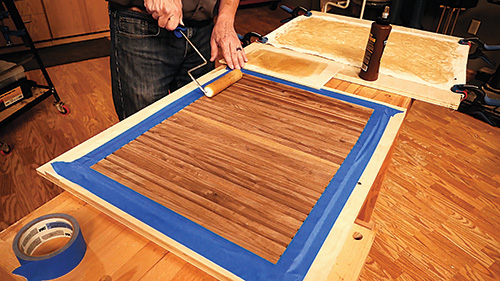
With the sticks in their jig, use blue masking tape to create a boundary for the hide glue when it is applied. Cut your canvas oversized and spread the liquid hide glue onto both the canvas and the tambour assembly with a small roller. Put a heavier coat of glue on the canvas and a light coat on the assembly. Then carefully lay the canvas glue to glue, on top of the tambour panel and vigorously rub it smooth with your hand. The heat from the friction you create will help the bond form. After the glue has cured, use a razor knife to trim the canvas at the perimeter you formed with the masking tape. It works really slick. Remove the panel from the jig and test the fit in the console carcass. Repeat the process for the second panel.
Adding the Interior Components
Take some time now to cut the vertical dividers and their shelves. I drilled 1/4″ holes for shelf pins in just the left-hand compartment, but you can make the shelves in both compartments adjustable if you prefer. I applied a hardwood strip to their front edges, as well as on the vertical dividers. I stopped those strips to create two small notches at either end of the dividers (see the Drawings) so these strips would hide the end of the routed dadoes. Create the plywood back panel for the internal compartment, and set all those pieces aside for now.
Next, make the walnut stiles that are located on both sides of the carcass, where they are set back in the opening about 1/4″ to hide the curve in the tambour track. They need to fit tightly and are attached with pocket hole screws. The carcass’s back panel is 1/4″ Masonite — very typical of this construction style. Go ahead and cut a piece to fit.
There are four tiny track filler pieces that you need to make now, as well. They fill in small gaps in the tambour track that were incidentally formed when the dadoes for the vertical dividers were cut. See the Drawing for details.
Add Orange to Your Walnut
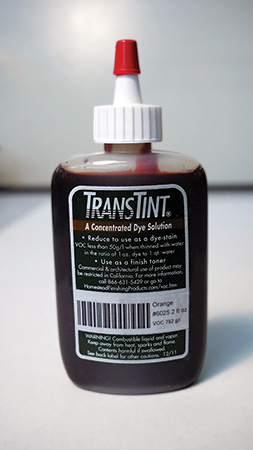
Walnut lumber that has been kiln-dried sometimes ends up looking gray and wan. Our finishing expert, Michael Dresdner, recommends using an orange dye on bland-looking walnut to pop the colors that may have been muted by the drying process. The dye is easy to use: mix it with water, flood it onto the wood and then wipe it off. In the case of our console, the outcome was stunning.
Finishing and Final Assembly
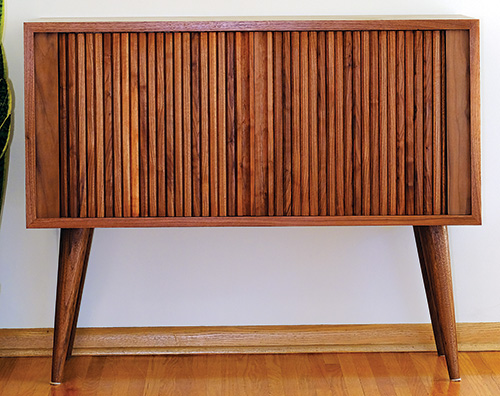
Well, you’ve been waiting for it … it is time to sand! I sanded all the hardwood pieces of the console up through 600-grit, because I wanted a specific finish that is slightly out of the norm. For me, the beauty of the walnut was paramount. So, my plan was as follows: sand ultra-smooth, apply an orange dye (suspended in water) to the walnut, use #0000 steel wool to polish down the grain that the water-based dye raised, apply a thinned coat of Zinsser® SealCoat™ to seal the wood cells, and then apply three coats of clear BRIWAX® using more #0000 steel wool, allowing the wax to dry between coats and buffing it with a soft clean cloth. In my opinion, this delivers a perfect Mid-Century Modern finish and truly enhances the piece.
After the finish was applied, I assembled the components, starting by attaching the legs with hide glue and T bolts. Then I added the interior components, slid the tambour doors into their tracks, installed the track spacers and finally tacked the back panel in place.
While I am taking credit for this project, it was truly a group effort. The good news for you is that we figured out all the details and you can build it and properly get all the credit.
Click Here to Download the Drawings and Materials List.
Hard-to-Find Hardware:
TransTint Orange Dye (1) #22307
1/4″ Nickel Pin Supports (1) #22773
Rockler Tambour Router Bit Set (1) #61896
Slipstick Round Self-Stick Felt Pads (1) #57071
Rockler High-Carbon Steel Forstner Bit (1) #56974
T-Slot Bolts-5/16″ – 18 Thread 1″ Long (4) #33965
Hex Drive Threaded Inserts (1) #31880





